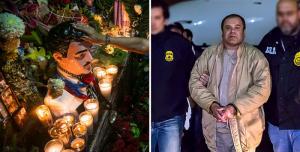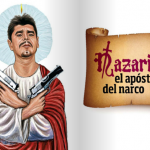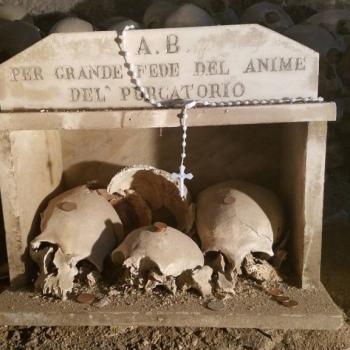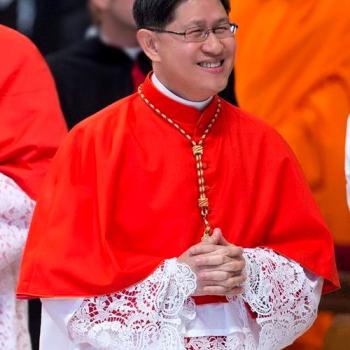
Co-authored by Dr. Kate Kingsbury* and Dr. Andrew Chesnut
While many Americans are now familiar with Santa Muerte, her less known paisano or compatriot, fellow Mexican folk saint Jesús Malverde is increasingly visible on both sides of the border. His latest appearance, to the great surprise of many, was in the Brooklyn court where El Chapo Guzman is being tried on multiple accounts of drug trafficking. One of Guzman’s attorneys claimed the 6 inch figure of the mustachioed Sinaloan folk saint “..miraculously appeared” in their court conference room the very day that former Sinaloa Cartel capo Jesús Zambada testified against El Chapo as a government witness. Presumably some of Guzman’s defense team, if not El Chapo himself, are petitioning the popular Mexican folk saint for a miracle of acquittal.
Some readers might have seen Jesús Malverde in AMC’s Breaking Bad. In an episode entitled “Negro y Azul,” a DEA agent who keeps a Malverde bust on his desk to “help him know his enemy” refers to him as the patron saint of drug dealers. Others might have tried the Mexican beer named in his honor. In fiction and news media, Jesús Malverde is often depicted as simply the patron saint of drug traffickers, or el narcosantón. Such portrayals are simplistic, however. Absent from these representations are Malverde’s appeal to the poor, the sick, construction workers, and migrants. While he is more commonly known as as el narcosantón to outsiders, to his hundreds of thousands of devotees he is el ángel de los pobres, the angel of the poor.
According to legend, Jesús Malverde was born Jesús Juárez Mazo on December 24, 1870, just outside Culiacán, the state capital of Sinaloa. During Malverde’s youth, railroads arrived in Sinaloa bringing large-scale hacienda agriculture. He witnessed his community undergo rapid socioeconomic transformation. The profits of hacienda agriculture were enjoyed by the few elite, while the vast majority of the population, the peasantry, faced even greater economic strain. Jesús Malverde is said to have been a carpenter, tailor or railway worker. It was not until his parents died of either hunger or a curable disease (depending on the version of the story) that Jesús Malverde turned to a life of banditry.
Jesús Malverde quickly earned a reputation as el bandido generoso, a generous bandit. Akin to Robin Hood in England, he was seen as a heroic outlaw who stole from the rich and distributed the plunder to the poor. It is said that his sobriquet derives from El Mal Verde, “the Green Evil”, since he supposedly assaulted his victims as they made their way through the fecund forests of the Sierra Madre mountains. In the most popular version of the Malverde legend, the governor of Sinaloa, Francisco Cañedo, personally challenged Malverde to steal either his sword or his daughter, promising that if successful he would be granted a pardon. According to lore, Malverde flitted through the governor’s mansion like a ghost, brazenly stealing Cañedo’s sword and leaving this message upon the wall: “Jesus M. was here.” Humiliated, the governor ordered him hanged with his arms tied behind his back. As a show of force, local authorities refused to allow Malverde to be buried and his body was left hanging until the bones fell to the ground. Over time, peasants threw small stones towards his remains as a sign of respect, eventually forming a rocky shroud over the bones.
The tragic death of Jesús Malverde is the salient aspect of his legend. Very little is known about Jesús Juárez Mazo, other than his execution in the year 1909. What is clear are the similarities shared between Malverde and two famous Sinaloan bandits, Heraclio Bernal and Felipe Bachomo. Malverde seems to be a synthesis of these two historical figures, while the execution of Jesús Juárez Mazo can be seen as the catalyst for the development of the folk devotion. His death at the hands of corrupt authorities appeals to the marginalized because they are vindicated through his victimization. Although the disenfranchised of Sinaloa lost a hero, they were compensated with a folk saint who has the power to work miracles on all fronts.
Most Malverde devotees are from the underclass of Sinaloa and northern Mexico. In the mustachioed saint they see a supernatural version of themselves. Alms collected at the Jesús Malverde Chapel in Culiacan– the most generous donations usually originating from the pockets of affluent drug barons- are often used to purchase wheelchairs and crutches for the handicapped, as well as for caskets for those who can’t afford them and even free breakfasts for hungry local children. The majority of petitions to Malverde concern health, money, family problems, unrequited love, employment, educational challenges, legal setbacks, arrest, imprisonment, crop failures and business difficulties. Jesús Malverde is believed to protect and provide succor to those that need it, regardless of social standing.
The folk saint began his debut as the patron saint of narcotraficantes in the 1970s, when Sinaloan drug baron Julio Escalante discovered that his son, Raymundo, was doing business with a rival cartel. He ordered sicarios to eliminate him. Raymundo Escalante was shot and disposed of in the sea. The dying man prayed fervently to Jesús Malverde for rescue. Seemingly miraculously, Escalante junior was rescued by a local fisherman and recovered from the shooting. He attributed his survival to the folk saint, whom, he stated had answered his prayers. However, it was in the 1980s and 90s as the Colombian drug cartels began to wither away and the Mexican drug cartels burgeoned, that the popularity of the Malverde cult skyrocketed. The association of el ángel de los pobres with the drug trade must be considered as a deliberate public relations strategy by the regional cartels. Association with Jesús Malverde allowed the Sinaloa Cartel to appropriate his Robin Hood-like characteristics to their criminal enterprise. Investment in community infrastructure on the part of the drug gangs coupled with the government’s reputation as corrupt and absent contributed to this populist image. It is advantageous for narcos to appear as though they are simple, faith-filled folk.
Narco-dollars have brought more than jobs and infrastructure to Sinaloa. They revitalized and reinforced old customs, one of which is the veneration of folk saints such as Jesús Malverde. The influx of drug money to the cult of Malverde has led to mushrooming shrines across Mexico and even into the U.S. and Colombia, but the macho folk saint’s deepening ties to narco-culture has created serious problems for devotees. In many instances law enforcement on both sides of the border assume that Malverde images are an indicator of involvement with the drug trade. Today still, devotees gather at his graveside where they continue to sling stones onto the sepulchre as they supplicate the saint. They also offer flowers and votives. Many also build altars to the folk saint. His days are said to be Mondays and Saturdays as he was purportedly born on a Monday and died on a Saturday, according to local legend. Altars typically feature an effigy of Jesús Malverde at their center, often with a rosary around the saint’s neck and a crucifix to his side, but also oddly a cowboy hat upon his head, which attests to the syncretic origins of the cult. Devotees must always light at least two candles preferably white and place these on either side of their icon.
It is no surprise that El Chapo’s defense team, and no doubt El Chapo himself, have turned to the folk saint for aid in the trial. Unlike the official Catholic saints, Jesús Malverde has a nefarious reputation and is said by some not only to have robbed but also to have killed. He is known for being a rogue who enjoys oblations of tequila, whisky, lit cigars or cigarettes, marijuana, ostensibly occasionally asks for girly mags and even requests that female devotees flash him. Unlike la Virgen de Guadalupe, such a brigand can be supplicated for all manner of dirty deeds, and as an outlaw himself is believed to overlook felonious activities. Who better for Mexico’s billionaire drug baron and his legal troupe to supplicate than the sanctified spirit of a mythical, mystical, mischievous malefactor?
*Dr. Kate Kingsbury obtained her doctorate in anthropology at the University of Oxford, where she also did her Mphil. Dr. Kingsbury is a polyglot fluent in English, French, Spanish. She is a polymath interested in exploring the intersections between anthropology, religious studies, philosophy, sociology and critical theory. Dr. Kingsbury is Adjunct Professor at the University of Alberta, Canada. She is fascinated by religious phenomena, not only in terms of their continuity across the Holocene and into the Anthropocene but equally interested in the changes wrought to praxis and belief by humans ensuring the infinite esemplasticity that is inherent to all religions, allowing for their inception, survival, alteration, regeneration and expansion across time and space. Dr. Kingsbury is a staunch believer in equal rights and the power of education to ameliorate global disparities. She also works pro bono for a non profit organisation that aims to empower and educate girls in Uganda. Follow Dr. Kingsbury on Twitter













